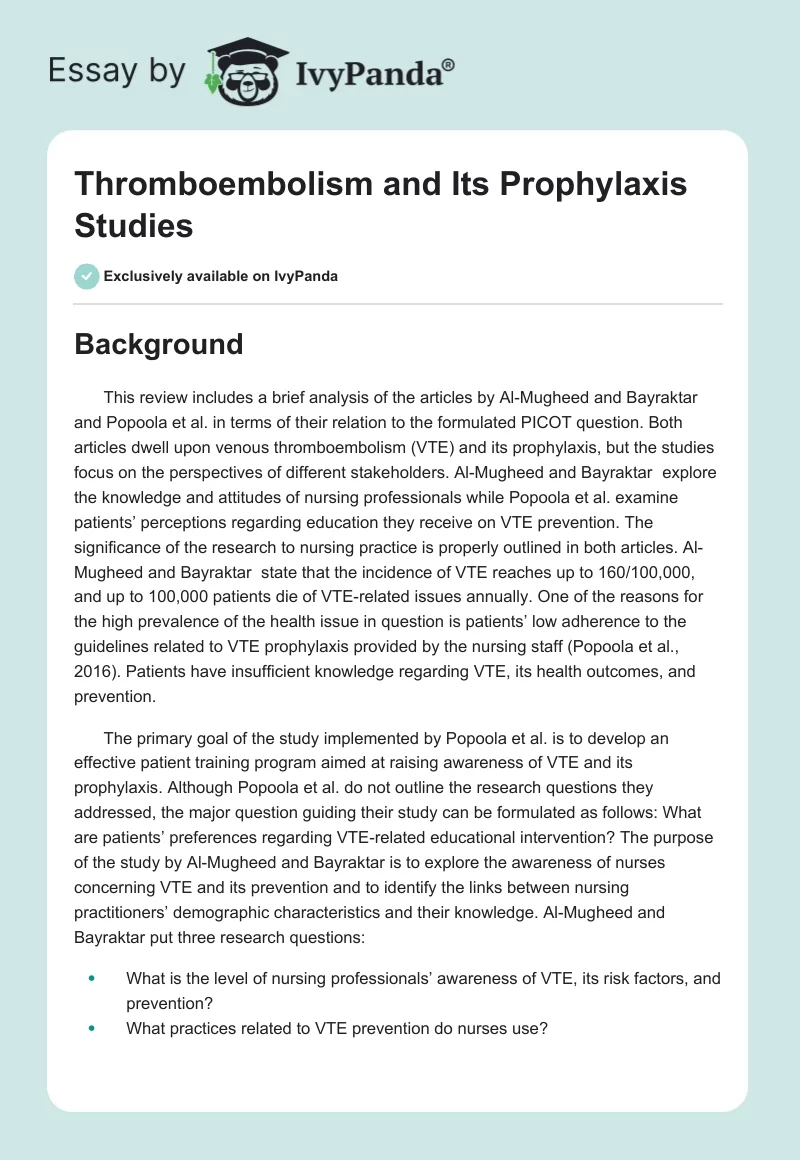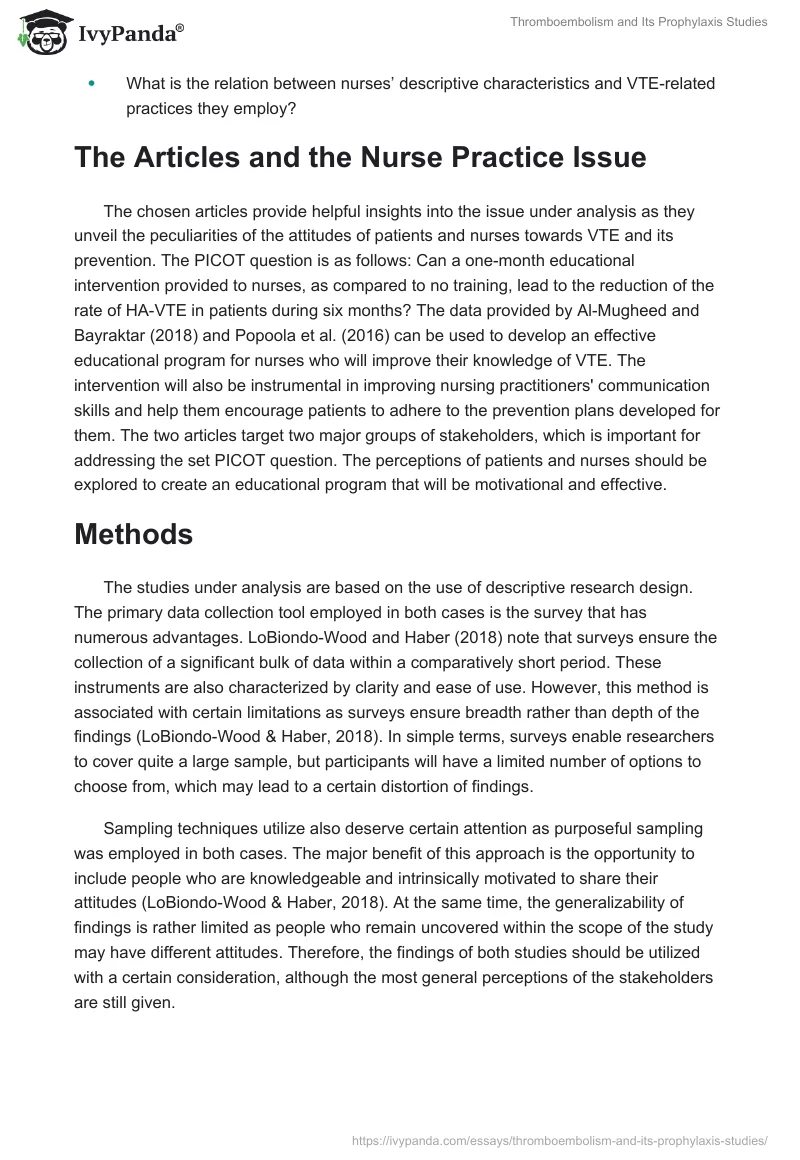Background
This review includes a brief analysis of the articles by Al-Mugheed and Bayraktar and Popoola et al. in terms of their relation to the formulated PICOT question. Both articles dwell upon venous thromboembolism (VTE) and its prophylaxis, but the studies focus on the perspectives of different stakeholders. Al-Mugheed and Bayraktar explore the knowledge and attitudes of nursing professionals while Popoola et al. examine patients’ perceptions regarding education they receive on VTE prevention. The significance of the research to nursing practice is properly outlined in both articles. Al-Mugheed and Bayraktar state that the incidence of VTE reaches up to 160/100,000, and up to 100,000 patients die of VTE-related issues annually. One of the reasons for the high prevalence of the health issue in question is patients’ low adherence to the guidelines related to VTE prophylaxis provided by the nursing staff (Popoola et al., 2016). Patients have insufficient knowledge regarding VTE, its health outcomes, and prevention.
The primary goal of the study implemented by Popoola et al. is to develop an effective patient training program aimed at raising awareness of VTE and its prophylaxis. Although Popoola et al. do not outline the research questions they addressed, the major question guiding their study can be formulated as follows: What are patients’ preferences regarding VTE-related educational intervention? The purpose of the study by Al-Mugheed and Bayraktar is to explore the awareness of nurses concerning VTE and its prevention and to identify the links between nursing practitioners’ demographic characteristics and their knowledge. Al-Mugheed and Bayraktar put three research questions:
- What is the level of nursing professionals’ awareness of VTE, its risk factors, and prevention?
- What practices related to VTE prevention do nurses use?
- What is the relation between nurses’ descriptive characteristics and VTE-related practices they employ?
The Articles and the Nurse Practice Issue
The chosen articles provide helpful insights into the issue under analysis as they unveil the peculiarities of the attitudes of patients and nurses towards VTE and its prevention. The PICOT question is as follows: Can a one-month educational intervention provided to nurses, as compared to no training, lead to the reduction of the rate of HA-VTE in patients during six months? The data provided by Al-Mugheed and Bayraktar (2018) and Popoola et al. (2016) can be used to develop an effective educational program for nurses who will improve their knowledge of VTE. The intervention will also be instrumental in improving nursing practitioners’ communication skills and help them encourage patients to adhere to the prevention plans developed for them. The two articles target two major groups of stakeholders, which is important for addressing the set PICOT question. The perceptions of patients and nurses should be explored to create an educational program that will be motivational and effective.
Methods
The studies under analysis are based on the use of descriptive research design. The primary data collection tool employed in both cases is the survey that has numerous advantages. LoBiondo-Wood and Haber (2018) note that surveys ensure the collection of a significant bulk of data within a comparatively short period. These instruments are also characterized by clarity and ease of use. However, this method is associated with certain limitations as surveys ensure breadth rather than depth of the findings (LoBiondo-Wood & Haber, 2018). In simple terms, surveys enable researchers to cover quite a large sample, but participants will have a limited number of options to choose from, which may lead to a certain distortion of findings.
Sampling techniques utilize also deserve certain attention as purposeful sampling was employed in both cases. The major benefit of this approach is the opportunity to include people who are knowledgeable and intrinsically motivated to share their attitudes (LoBiondo-Wood & Haber, 2018). At the same time, the generalizability of findings is rather limited as people who remain uncovered within the scope of the study may have different attitudes. Therefore, the findings of both studies should be utilized with a certain consideration, although the most general perceptions of the stakeholders are still given.
Results
As far as the results of the studies under consideration are concerned, Al-Mugheed and Bayraktar report that nurses have sufficient general knowledge regarding VTE. Nurses tend to be aware of the most common symptoms, the processes in the human body that take place, and some prevention strategies. However, their awareness of associated risk factors, prevention, and employed practices is insufficient. Nursing professionals tend to use only a limited set of practices linked to HA-VTE prevention (Al-Mugheed & Bayraktar, 2018). Popoola et al. also utilize surveying and claim that patients prefer being taught on VTE symptoms, major risk factors, and prophylaxis. The patient-doctor format of training delivery is preferable. It is also reported that patients are willing to receive additional materials, including visuals and videos (Popoola et al., 2016). The study shows that people are willing to receive diverse information related to their health.
As mentioned above, the primary contribution of the articles in question is the identification of the existing gaps regarding people’s knowledge on VTE and their attitudes towards different aspects of the disorder prophylaxis. One of the most valuable findings is provided by Al-Mugheed and Bayraktar (2018) who identify the link between nurses’ descriptive characteristics and their knowledge of the disorder under analysis. The researchers also examine the practices nurses use to provide care to patients. It is found that nurses with Bachelor’s degrees or higher and working experience between 6 and 10 years have more comprehensive knowledge and use diverse practices.
Outcomes Comparison
The anticipated outcomes of the PICOT question include the decrease in the rate of HA-VTE incidence and improved skills of nursing professionals after the implementation of the educational intervention. It is expected that an educational intervention will equip nurses with the knowledge and skills necessary to encourage patients to adhere to HA-VTE prevention plans. Al-Mugheed and Bayraktar claim that nurses who have worked for a longer period are more effective when it comes to the provision of training to patients. Therefore, it is possible to expect that on-the-job training will contribute to nurses’ professional development and enable them to employ effective practices.
It is also clear that patients have various gaps in their knowledge regarding HA-VTE, but the study by Popoola et al. unveils the aspects patients are interested in. It can be expected that the inclusion of these concepts will improve patients’ motivation to adhere to prevention plans developed for them. The articles under analysis, as well as the PICOT question, are based on the assumption that continuous education of the nursing staff is beneficial for patients and their health outcomes.
References
Al-Mugheed, K. A., & Bayraktar, N. (2018). Knowledge and practices of nurses on deep vein thrombosis risks and prophylaxis: A descriptive cross-sectional study. Journal of Vascular Nursing, 36(2), 71-80. doi:10.1016/j.jvn.2018.02.001
LoBiondo-Wood, G., & Haber, J. (2018). Nonexperimental designs. In G. LoBiondo-Wood & J. Haber (Eds.), Nursing research: Methods and critical appraisal for evidence-based practice (pp. 180-198). St. Louis, MO: Elsevier Health Sciences.
Popoola, V. O., Lau, B. D., Shihab, H. M., Farrow, N. E., Shaffer, D. L., Hobson, D. B., … Haut, E. R. (2016). Patient preferences for receiving education on venous thromboembolism prevention – a survey of stakeholder organizations. PLOS ONE, 11(3), 1-10. doi:10.1371/journal.pone.0152084


